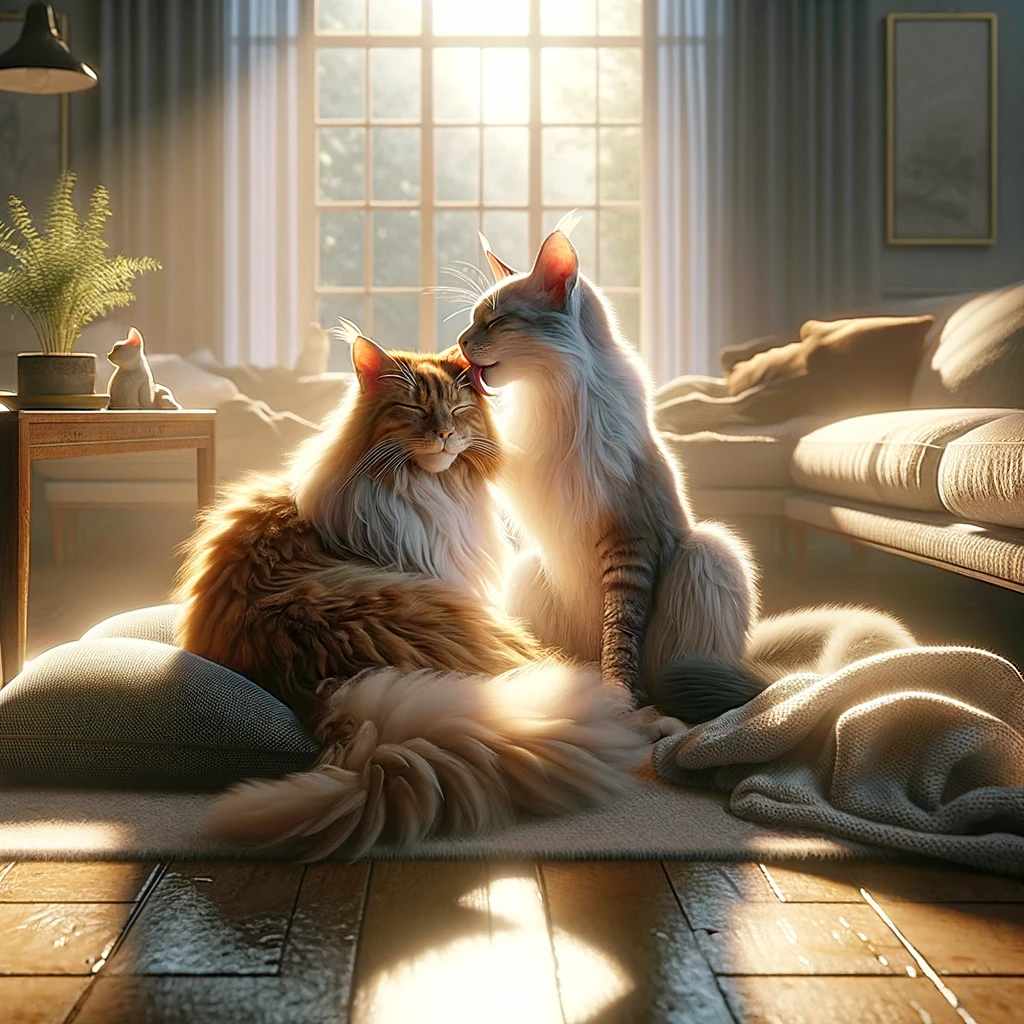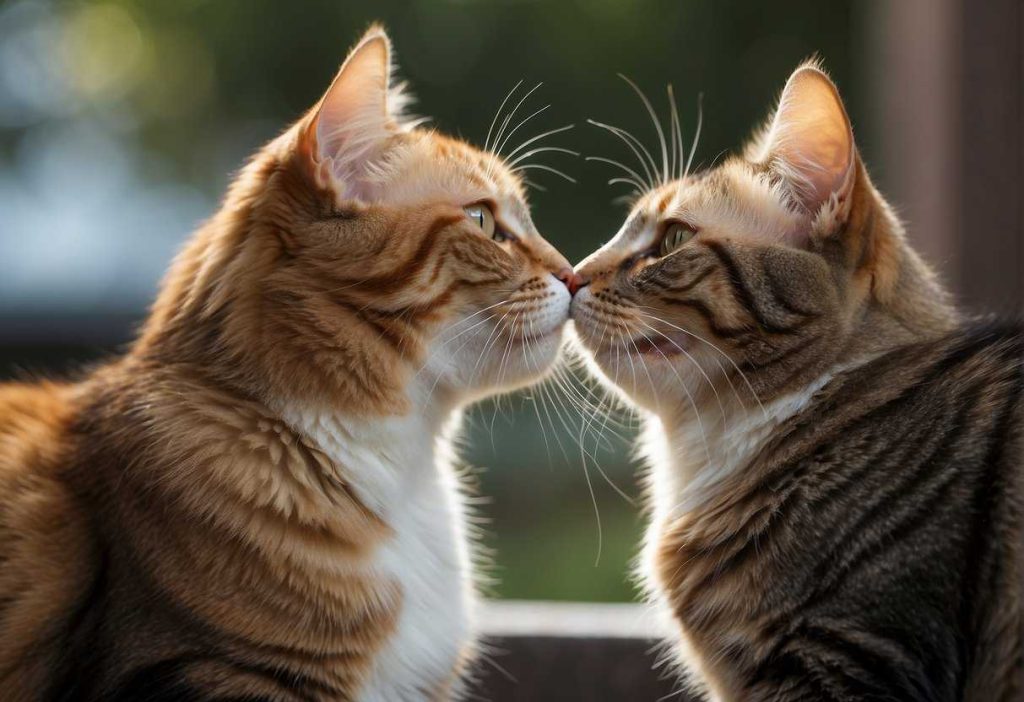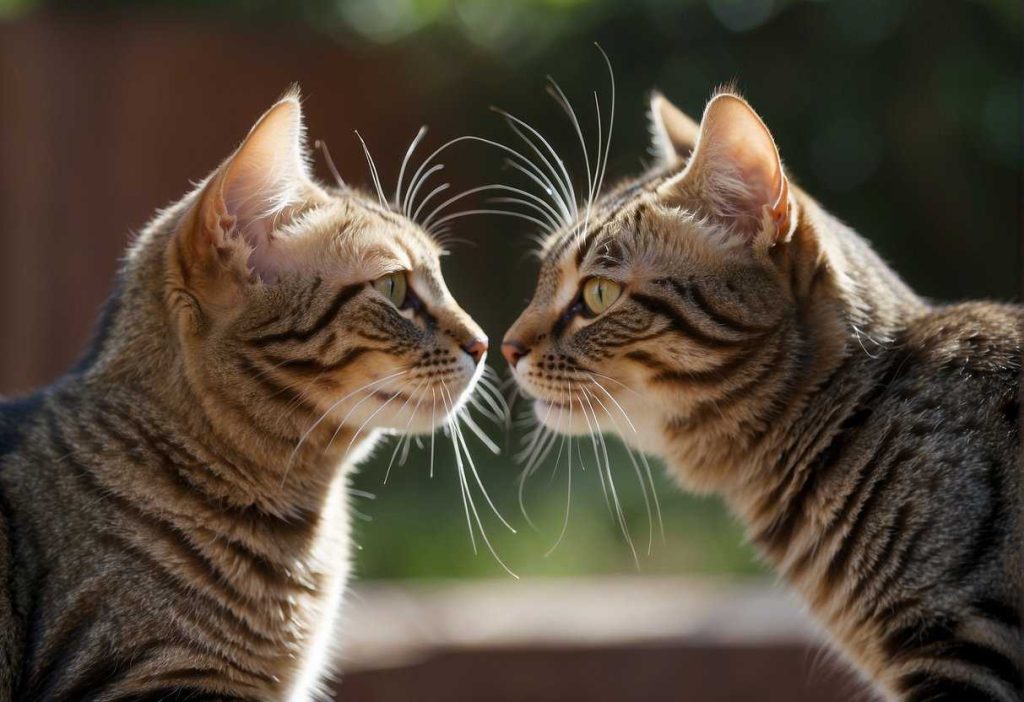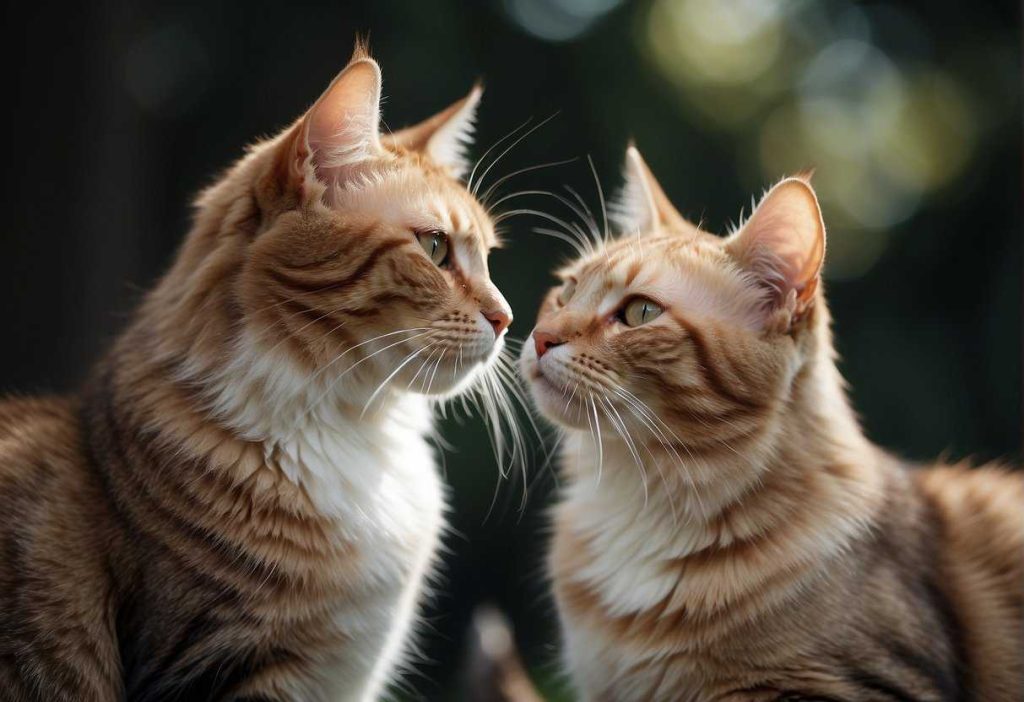Have you ever watched a couple of cats in a serene moment and wondered why do cats lick each other so earnestly? This behavior, known as allogrooming, is an intrinsic part of a cat’s social dynamics. (1)
It’s about more than just cleanliness; it acts as a multifaceted means of communication and bonding.
Understanding why cats engage in this behavior is like deciphering their private language, allowing us to peek into their complex social structures.

From establishing hierarchies to reinforcing friendships, allogrooming serves several key functions in the lives of cats.
It’s also fascinating to observe how this behavior varies among different cats or changes with the introduction of new household members.
Even more intriguing, isn’t it, to uncover that this behavior may have a tangible impact on the harmony within a multi-cat environment?
Piecing together these behavioral puzzles not only satisfies our curiosity but also enables us, as cat owners or enthusiasts, to create a more agreeable and understanding living situation for our feline friends. (2)
Key Takeaways
- Allogrooming is a multifaceted social behavior among cats.
- It serves to communicate, establish social structures, and build relationships.
- Understanding this behavior can aid in creating harmonious multi-cat homes.
Why Do Cats Lick Each Other: Understanding the Behavior

The Basics of Allogrooming in Cats
You’ve probably noticed that grooming is a significant part of your cat’s daily routine. (3)
Those soothing licks aren’t just for keeping their fur coat spick and span. Grooming helps to bond with their companions, establish social hierarchies, and provide comfort. (4)
Here’s the scoop:
- Bonding: By grooming each other, cats build and maintain close relationships.
- Social Structure: Through licks and nuzzles, cats might sort out their social standing. (5)
- Comfort and Care: Grooming can be a way to show affection and care for fellow felines, offering comfort when one is stressed or ill.
Scientific Insights into Cat Grooming
Biologically speaking, allogrooming ticks several boxes in a cat’s instinctual checklist:
- Hygiene: Cats lick to clean hard-to-reach spots, promoting better hygiene. (6)
- Scent-marking: Grooming distributes their scent, crucial for marking territory and friends.
- Health Check: Licking can be a way of checking for wounds or parasites.
- Temperature Control: Saliva spread on fur helps to regulate body temperature.
These behaviors aren’t random—they’ve evolved for survival and sociability.
By understanding your cat’s grooming behavior, you’re tapping into the complex social world of felines.
So next time you catch your kitty in a licking loop with their pal, remember it’s all part of being a cat!
Key Reasons Behind Cats Grooming Each Other
Cats licking each other, known as allogrooming, isn’t just about staying clean – it’s a whole language in itself!
1. Bonding and Affection: Ever thought of a lick as a kitty kiss?
Cats groom each other to forge a strong bond, like family or close friends. It’s their cozy way of saying, “You’re part of my inner circle.”
2. Communication and Social Structure: Speaking of inner circles, grooming helps sort out who’s the head honcho and who follows.
It’s all about establishing who gets to sit on the highest branch of the cat tree, so to speak.
3. Maternal Instincts and Care: From day one, mama cats teach their kittens the A-B-Cs of grooming – it’s like their version of a bath and a cuddle combined.
4. Health and Hygiene:
- Cleanliness: Cats hate dirt more than a bad fur day!
- Parasite Control: Grooming buddies help each other kick those pesky fleas to the curb.
5. Emotional Well-being and Stress Relief: Feeling anxious? A grooming session can calm the nerves and spread purr-sonal joy.
So, next time you see your cats in a lick-lock, you’ll know it’s not just about spit and polish – it’s about love, language, and a touch of kitty hygiene!
Deepening Understanding Through Contextual Insights

Relaxed vs Stressful Grooming: You might see your cats engaging in a grooming session on a lazy Sunday afternoon. That’s a sign of trust and contentment.
But did you catch them licking more frantically during a thunderstorm? That’s a stress reaction, and it’s their way of finding comfort.
- Signs of Trouble in Paradise:
- Have you spotted bald patches or irritated skin? That could be a red flag for excessive grooming.
- Ever witnessed a lick-fest turn into a hissy fit? That’s problematic grooming behavior!
Here are a couple of suggestions for when grooming goes overboard:
- Distraction: Engage your cat with a toy or a treat when you see them going ham on licking.
- Check-Up: A visit to the vet can help rule out any underlying skin issues or allergies.
Understanding your furball’s grooming nuances can help you create a happier, stress-free environment for them.
Just keep an eye out for the subtle cues, and you’re on your way to becoming a cat-whispering pro!
Enhancing Harmony in Multi-Cat Households

Dynamics of Grooming in Multi-Cat Settings
When cats groom each other, it’s a sign of trust and camaraderie. They essentially share their scent, which creates a communal group odor; this is a big deal in the cat world!
It’s like wearing a family uniform that says, “We belong together.”
- Introducing a New Cat: When you bring a new cat into the mix, they might feel like the odd one out. How can you help them fit in? Start with controlled introductions and give them time to acclimate. Once they’re comfortable, they’ll start to participate in grooming sessions, becoming part of the family scent.
- Encouraging Positive Grooming Behavior: To foster this peaceful behavior, make sure each cat has enough space—think of tall cat trees and multiple sleeping spots. Having individual food bowls and litter boxes also reduces competition, making them more likely to bond through licking.
Strategies for Promoting Healthy Grooming Among Cats
Looking to encourage these Zen moments? Here’s a tip: Reward peaceful grooming with treats and affection!
- This positive reinforcement tells your cats that you love seeing them in harmony.
- Keep stress levels down. Cats can become anxious with too much noise or change, so maintain a calm environment.
- Offer communal toys that they can enjoy together, strengthening their bonds.
- Keep an eye out for over-grooming. It’s rare, but if one cat is too aggressive, it could stress out the other, so intervene if necessary.
By understanding these little rituals, you’re well on your way to a blissful, purring paradise at home! Remember, a group cuddle session is always a good sign.
Leveraging Expertise for Comprehensive Understanding

Grooming Basics:
Cats lick each other as a form of social bonding, a behavior observed from their early kitten days when their mother would lick them clean.
This comforting behavior extends into adulthood and signifies trust and care within a cat community.
Expert Insight:
- Social Hierarchy: At times, a dominant cat will initiate grooming to reinforce social hierarchy within the group.
- Stress Relief: Cats also lick each other to reduce stress and anxiety, promoting a peaceful environment.
Practical Toolkit:
- Grooming Brush – Encourages bonding if used gently.
- Comb – Helps remove tangles and can make grooming sessions more enjoyable.
- Wipes – For cats that are less fond of grooming, you can use pet wipes to keep their coat clean.
Creating a grooming-friendly environment is key.
Ensure that your cats have a comfortable space to groom without feeling threatened. This makes the experience much more enjoyable and beneficial for them.
So next time you catch your cats in a grooming session, take a moment to appreciate this intricate part of their social lives.
With the right tools and a pinch of understanding, you’ll see the depth of their commitment to one another, and it’s all thanks to the wisdom shared by the experts.
Keep an eye out for the subtleties of feline communication, and you’ll be able to support their bonding rituals with ease and know-how!
Real-Life Stories and Case Studies

Case Study
Tommy and Simba’s Grooming Ritual
- Owner: Sarah K.
- Observation: Every evening, like clockwork, her cats start their grooming session.
- Details: Tommy grooms Simba’s ears for a good ten minutes, followed by reciprocal grooming.
Why does this happen? It’s simple!
Cats groom each other to strengthen bonds – it’s their way of showing love and trust.
Exhibit A
The Kitty Grooming Chain
- Veterinarian Insight: Dr. L. Nguyen explains that cats form a “grooming chain” where multiple cats may lick each other in turns, displaying a social hierarchy.
Wondering if your cat’s position in the chain means something? You bet!
It often reflects their standing in the social group.
Personal Tale
Muffin and Whiskers’ Selective Licking
- Owners: Jane and Rick P.
- Scenario: Muffin only licks Whiskers’ face, never his back.
- Vet Input: Some cats are picky groomers; they may choose certain body parts over others due to ease of access or preference.
It’s quirks like these that keep cat ownership interesting, isn’t it?
Here’s a quick snapshot:
| Cat Buddies | Body Part Groomed | Frequency | Owner’s Name |
|---|---|---|---|
| Tommy & Simba | Ears | Daily | Sarah K. |
| Muffin & Whickers | Face | Sporadically | Jane and Rick P. |
Just by looking at these snippets of cat life, you get to see the mix of practicality and preference in their grooming habits.
So, next time you catch your cats in the act, you’ll know there’s a whole story behind each lick!
Quick Recap

Grooming each other, or allogrooming, has several benefits for cats, including:
- Building social bonds: Just like you’d feel closer to someone after a good chat, cats licking each other create and maintain friendships.
- Health checks: It’s their way of keeping an eye out for potential issues, literally scratching each other’s backs!
Allogrooming isn’t just for cleanliness; it’s vital to their well-being, indicating trust and companionship among cats. (7)
Remember:
- Stress reduction: A good lick can be the equivalent of a calming massage.
- Behavioral benefits: It reduces the chance of conflicts in multi-cat households.
Key Takeaways:
- Cats lick each other to strengthen social bonds.
- This behavior serves as a preventative health measure.
- It helps alleviate stress and minimize tension.
Aren’t cats just purr-fectly clever?
Keep an eye on your cats’ grooming habits—it’s a big part of their social life and overall health!
Frequently Asked Questions

Cats licking each other can be puzzling yet endearing behavior, revealing much about their social bonds and communication. Let’s unravel some common queries you might have about this feline habit.
Why do cats lick each other’s heads and necks?
Cats lick each other’s heads and necks as part of their social grooming, or allogrooming, which helps to establish and strengthen bonds between them.
It’s also a practical area for them to groom since cats have a hard time reaching these spots on their own.
Could grooming indicate which cat is trying to be dominant?
Grooming can sometimes be a display of dominance, with the dominant cat often initiating the grooming.
However, it’s not a universal sign of dominance, as it can also be a mutual or submissive gesture between cats.
Why might one cat groom another cat’s ears?
Ear grooming is a sign of intimacy and trust.
Cats have scent glands in their ears, so when one cat grooms another’s ears, they’re mingling scents, which reinforces their social bonds.
Is it normal behavior for male cats to groom each other?
Yes, it’s normal and healthy for male cats to groom each other.
This behavior shows that they are comfortable with one another and that they are establishing a friendly relationship or maintaining social bonds.
Sometimes my cats groom and then fight; is this common?
It’s quite common for cats to switch from grooming to play-fighting or real aggression due to overstimulation or unresolved tension.
Keep an eye on their body language to understand the tone of the interaction.
Why do cats occasionally bite after grooming each other?
A gentle bite can be part of the grooming process but if the biting is aggressive, it may indicate irritation or overstimulation.
This is especially true if the grooming session is lengthy or too intense for one cat’s preference.
How can grooming behavior help me understand my cat’s emotional health?
Observing grooming behavior among cats offers insights into their relationships and mood.
Consistent grooming usually reflects contentment, while a lack of grooming might suggest stress or illness.
Pay attention to changes in grooming behaviors for clues about your cat’s emotional health.


